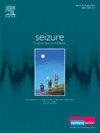ATP2B1变异与无神经发育障碍的全身性癫痫相关及其潜在机制
IF 2.8
3区 医学
Q2 CLINICAL NEUROLOGY
引用次数: 0
摘要
ATP2B1基因编码质膜钙转运ATPase 1 (PMCA1),该基因主要在大脑中表达,在细胞内钙稳态中起重要作用,可能影响神经元的兴奋性和突触传递。先前的研究已经在神经发育障碍患者中发现了ATP2B1变异。然而,ATP2B1变异在癫痫中的意义尚不清楚。方法对无获得性病因的癫痫患者进行基于strio的全外显子组测序(WES)。为了确定基因与疾病的关联,我们回顾了先前报道的ATP2B1变异,并分析了变异的破坏性影响、基因型-表型相关性和时空表达模式。结果在5例全身性癫痫或遗传性癫痫伴热性发作患者中发现satp2b1基因变异。鉴定到的ATP2B1变异包括1个全新杂合错义变异(c.2920A>G/p.Ile974Val)和1个共分离杂合错义变异(c.76G>A/p.Asp26Asn)。根据美国医学遗传学和基因组学学院(ACMG)的标准,重新出现的变异在任何公共人群数据库中都不存在,并被评估为可能致病。共分离变异在gnomAD中具有极低的次要等位基因频率(MAF = 7.955×10−6)。计算模型分析表明,这两种变异导致了蛋白质稳定性的损害。所有患者均无神经发育障碍,预后良好。进一步分析显示,与神经发育障碍相关的变异要么是双等位基因变异,要么是单等位基因截断/错义变异,其特征是氢键和/或疏水性的显著改变,以及极高的AlphaMissense评分;而癫痫相关的变异是错义变异,损害相对较小,导致氢键或疏水性没有变化。值得注意的是,位于功能域具有严重破坏性影响的错义变异更有可能表现为与癫痫共病的神经发育障碍。此外,ATP2B1在早期发育阶段表现出相对较低的基线表达,但在后期显著增加,在纹状体中表达特别高,这与本研究中观察到的全面性癫痫表型一致,并解释了严重损伤变异与早发性神经发育障碍有关,而轻度损伤变异与癫痫有关。atp2b1是全身性癫痫的潜在候选基因。遗传依赖阶段(GDS)、基因组织特异性表达和基因型-表型相关性有助于解释表型异质性。本文章由计算机程序翻译,如有差异,请以英文原文为准。
ATP2B1 variants associated with generalized epilepsy without neurodevelopmental disorders and the underlying mechanism
Background
The ATP2B1 gene encodes the plasma membrane calcium-transporting ATPase 1 (PMCA1), which is predominantly expressed in the brain and plays an essential role in intracellular calcium homeostasis, potentially affecting neuronal excitability and synaptic transmission. Previous studies have identified ATP2B1 variants in patients with neurodevelopmental disorders. However, the significance of ATP2B1 variants in epilepsy remains unknown.
Methods
Trio-based whole-exome sequencing (WES) was performed in the cohorts of patients with epilepsy without acquired etiologies. To define the gene-disease association, we reviewed previously reported variants of ATP2B1 and analyzed the damaging effects of the variants, genotype-phenotype correlation, and spatial-temporal expression pattern.
Results
ATP2B1 variants were identified in five individuals affected by generalized epilepsy or genetic epilepsy with febrile seizures plus from two unrelated families. The identified ATP2B1 variants included one de novo heterozygous missense variant (c.2920A>G/p.Ile974Val) and one co-segregated heterozygous missense variant (c.76G>A/p.Asp26Asn). The de novo variant was absent in any public population database and was evaluated as likely pathogenic according to the criteria of the American College of Medical Genetics and Genomics (ACMG). The co-segregated variant had an extremely low minor allele frequency (MAF = 7.955×10−6) in gnomAD. Computational modelling analysis suggested that the two variants led to impairment in protein stability. All of the patients had favourable outcomes without neurodevelopmental disorders. Further analysis revealed that neurodevelopmental disorders-associated variants were either biallelic variants or monoallelic truncation/missense variants, characterized by significant alterations in hydrogen bonding and/or hydrophobicity, along with extremely high AlphaMissense scores; while epilepsy-associated variants were missense variants with relatively little damage, resulting in no changes in hydrogen bonding or hydrophobicity. Notably, missense variants located in the functional domain with severe damaging effect were more likely to manifest as neurodevelopmental disorders comorbid with epilepsy. Additionally, ATP2B1 exhibits relatively low baseline expression at early development stages but significantly increases in later stages, with particularly high expression in the striatum, which is consistent with the generalized epilepsy phenotype observed in this study, and explains that severe damage variants were associated with early-onset neurodevelopmental disorders, whereas milder damage variants were associated with epilepsy.
Significance
ATP2B1 is a potential candidate gene for generalized epilepsy. Genetic dependent stage (GDS), gene tissue-specific expression and genotype-phenotype correlation contribute to the explanation of phenotypic heterogeneity.
求助全文
通过发布文献求助,成功后即可免费获取论文全文。
去求助
来源期刊

Seizure-European Journal of Epilepsy
医学-临床神经学
CiteScore
5.60
自引率
6.70%
发文量
231
审稿时长
34 days
期刊介绍:
Seizure - European Journal of Epilepsy is an international journal owned by Epilepsy Action (the largest member led epilepsy organisation in the UK). It provides a forum for papers on all topics related to epilepsy and seizure disorders.
 求助内容:
求助内容: 应助结果提醒方式:
应助结果提醒方式:


